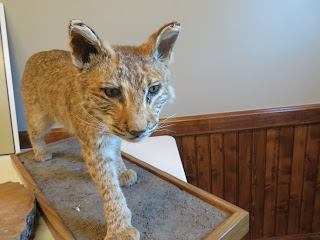Matt Perry is leading today's hike on 700 acres of recently acquired property, now part of Hanging Rock State Park. The recent rains and today's rain has dampened the turnout to just 11 Friends of Sauratown diehards. Historian, Steve Shelton makes an appearance with a large map. He gives us some historical commentary on the property. The nearby creek is Mill Creek, so, obviously, it has served in that capacity. After some interpreting, Steve takes off and we are wondering how we are going to get across the creek. Matt informs us, due to the wet condition today, we are not going to cross the raging torrent - Mill Creek. We just have to cross a tributary. He takes us to a spot to cross. He asks, is anyone unwilling to cross. No one spoke up but I knew I was not crossing there. It was an over the boot, fast moving creek which would take 3 or 4 steps to get across. Not wishing to start out with wet boots, I looked for another spot. At this point, someone suggests that there is wood in the shed we had been huddled in. Yes, there was some wood. We placed 4 pieces across the creek and all made the crossing without incident.
Once across the creek, we headed up through a laurel thicket and then through the woods to a field and an old road. Water was splashing with every step. After passing a couple old tobacco barns, we headed up on an old road. Then onto one which has a long rock wall alongside. We had to squirm through some blowdowns and cross a few swollen rivulets. Then, a massive rock appears before us, named, Stegosaurus Rock by Matt. It offered us shelter for a short break. Although, we were under the overhang, there was still a waterfall of sorts which emanated from the back of the overhang. I doubt I'll ever see that waterfall again.
Following the road for a bit more and then heading off trail, we end up along Mill Creek and walk to the park boundary. There is a deer blind and a feeder near here. Then it is about 3/4 mile up Mill Creek to the spot we must cross the tributary again. No mishaps once again.
Before we can leave, we have to push cars out of the mud. Several had sunk into the soft ground by as much as 6 inches. After everyone was out on pavement, I could head on. My 4 wheel drive Canyon handled the mud graciously.
Tammy 1 Cheap poncho 0
Mill Creek at its most ferocious
Did anyone have dry boots today?
One of the drier spots
Every square inch of the 700 acres is sodden today
MaryJoan crosses with flair
The last crossing
Dog of the Day
Fearless - or foolish?


















































